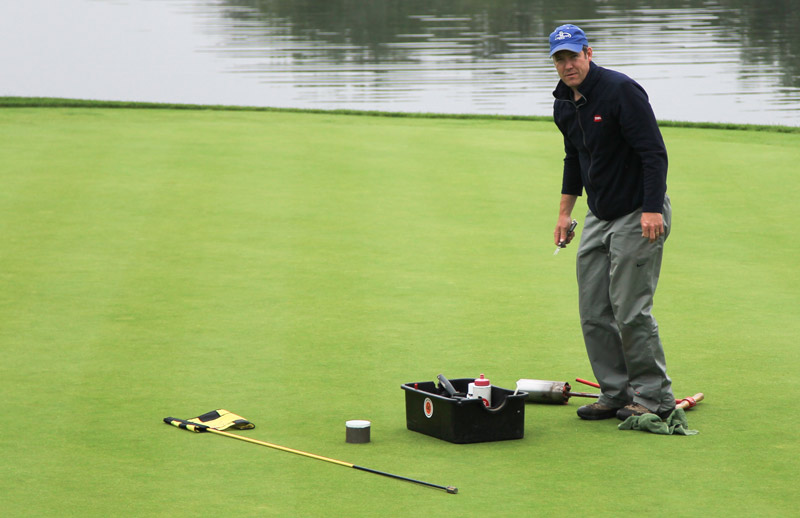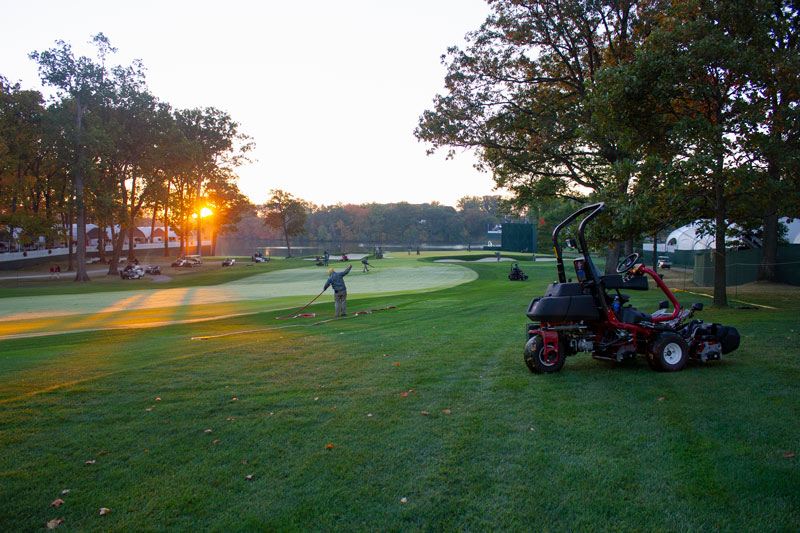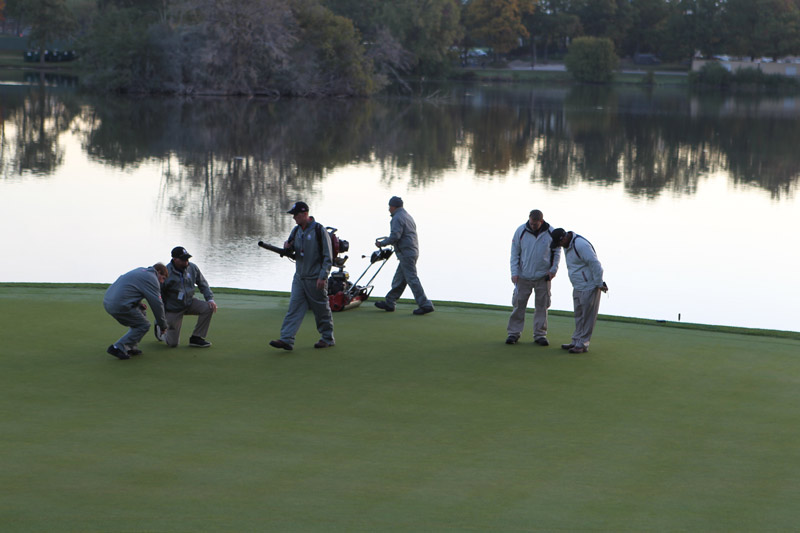
A flurry of volunteers on the 13th hole at Medinah (Ill.) Country Club during preparations for the 39th Ryder Cup, held Sept. 28-30, 2012. Photos courtesy of Darrick Robbins
Editor’s note: A version of this article was originally published in the July 2021 issue of On Course, the monthly publication of the Midwest Association of Golf Course Superintendents.
The atmosphere of a professional golf tournament is hard to beat. There is an energy and excitement inherent to these events. People you see on TV are there — the players and their caddies, the announcers. There are fancy cars, entourages, the rich and famous, and plenty of regular people too. At least once in your life, you should attend a professional golf tournament, and there may be no better way to do so than as a tournament grounds volunteer.
Professional golf tournaments are a different world in many ways, no more so than for the golf course maintenance staff. As much as anything, tournaments are a logistical exercise. The typical daily tasks still need to be accomplished — the grass still needs to be cut, the bunkers raked, the holes moved. The difference is that this work often needs to happen in a very short period of time. Weather, daylight, large fields and other factors, such as the presence of TV crews, often conspire to make it necessary to pull off a full day’s work in just a few hours.
When you need to get course maintenance done in a three- to four-hour span, having a lot of bodies to throw at all the tasks is vital. This is where tournament volunteers come in. And it’s also where one of the best characteristics of people in the golf industry comes to the fore: When someone needs a hand, we help each other another out.
I’ve been pitching in at professional events in the Chicago area for the past 10 years, and whether volunteering is in your plans in 2022 or further down the road, the following insights, do’s and don’ts can help you get the most out of the experience.
Tournament hosting 101
How does a golf course coordinate tournament volunteer efforts? It can differ quite a bit from place to place. I have witnessed it from the outside on numerous occasions, and in general, it goes something like this: Several months before the event, the host superintendent and their leadership team, with assistance from the PGA Tour agronomist, begin to put together assignments and schedules for the tournament. They try to consider every job that will need doing, including every eventuality. Other matters that need consideration early on include arranging lodging for some of the volunteers and occasionally for staff, as long hours are the norm; arranging transportation between lodging venues and the golf course; and arranging volunteer parking.
Eventually, a schedule (or several schedules) is produced that lays out how everything will go if the weather is perfect, and every superintendent hopes this schedule is the one they’ll end up using. A great deal of effort goes into planning for contingencies such as weather impacts, equipment failures and volunteer no-shows. And even if all goes perfectly, there will always be some items that need last-minute tweaking.
The schedule will have each worker, each machine and each task set for the week. Later on, after the list of volunteers has been compiled, the leadership will pair the tasks with the people who will be on hand. Some volunteers work only mornings, others only evenings, and some are there the entire time. Each person will be matched with the available equipment. Equipment vendors often loan sizable amounts of equipment to the golf course to facilitate this condensed course-preparation schedule.
When a course hosts a professional tournament, a number of roles on the maintenance staff need to be filled. The superintendent is often left as a free agent without much scheduled involvement, as the demand on their time will be heavy all week. The superintendent needs to be able to react to sudden developments and make last-minute changes as necessary, and the superintendent also deals with all the people outside the agronomy department. If it’s a “good” year, the superintendent might be pitching in wherever there’s a need, but if it’s a “bad” year, they could be spending all of their time reconfiguring the schedule and making decisions about when and how the course can be made playable; what resources need to be where; and how in the world the staff is going to get everything done in time for that opening tee ball each morning.

Author Darrick Robbins changing cups at the Encompass Championship, a Senior PGA Tour event held at North Shore Country Club in Glenview, Ill., from 2013 through 2015. Robbins has changed holes at several PGA, LPGA and Senior PGA Tour events.
One of the senior assistant superintendents is usually responsible for the course staff and volunteers during a tournament. The whole operation relies heavily on the full-time crew, as they know their way around the course and equipment and can help those who don’t. Often one of the other assistants is in charge of dealing with the infrastructure build during the lead-up to the tournament, making sure the course remains as intact as possible while everything gets moved in. Contractors often pull from local labor or subcontractors who know nothing about golf, so it’s always a challenge to get them in and out while inflicting as little damage as possible.
Things pick up a bit during “advance week,” the week prior to tournament week. The PGA Tour agronomist shows up, and any last-minute details on the course are addressed.
Volunteers enter the picture
The Monday of tournament week is when things really start ramping up. Pro-ams are held, practice rounds begin for the players, and spectators and volunteers begin to arrive. This is practice time for the maintenance staff too, and the time when the big, looming question will be answered: Is the plan for moving everyone around and getting things done viable?
The crew often stages a practice session or two of equipment mobilization, and any problems that arise are tackled. What adjustments need to be made because of changes to anticipated manpower or equipment or other factors? How has the infrastructure build impacted traffic flow? How is the weather shaping up? There really is no perfect plan, because every plan will have to be modified at some point. The key is having smart, flexible people working as a team. The one overriding feeling at these events is that the show must go on. One way or another, the tournament will be played.

Even superintendent Scott Bordner’s dog Wrigley lent a paw when Chicago Golf Club hosted the U.S. Senior Women’s Open in July 2018.
Early in advance week or the weekend before the tournament starts is when grounds volunteers come on board. There will be someone on hand who is responsible for checking in volunteers and getting them the gear they need. Generally, volunteers are asked to check in and get their gear during advance week, but many of those coming in from out of town don’t have that option.
There will usually be a swag bag awaiting you with some shirts, a hat, a badge that gets you where you need to go, and several other goodies (water bottles, backpacks, knives, bottle openers, etc.). Sometimes there’s also a rain suit. I’ve found the best “badge” that you can have at these tournaments is some piece of golf equipment. If you were to drive an old triplex down the street to the front gate of almost any tournament, chances are they’d let you in. But it’s still important to keep your real badge handy.
Few maintenance structures are large enough to accommodate a crew much larger than the course’s normal crew, so often there will be an additional structure installed for the grounds crew to hang out in. It’s usually a tent, and it can house food, couches, games and other diversions. Of course, a TV is a must — one truly surreal experience is watching something happen on TV moments after you hear the roar from out on the course. There’s always a lot of coffee and food, and typically a cooler stocked with a variety of nonalcoholic beverages. And, on occasion, usually in the evening after the late shift is over, it’s not unheard of for kegs to be wheeled out and for everyone to enjoy a beer or two.
The excitement builds as the week goes by, until finally the tournament begins. It’s rewarding to be part of a well-coordinated group intent on accomplishing a task, and it’s especially gratifying seeing a professional on TV playing out of a bunker you’ve raked or hitting off a fairway you’ve cut.
If a PGA event seems a little intimidating, consider volunteering at a smaller event. There are USGA qualifiers, Senior PGA and LPGA events, and other events running all the time.
Golf tournament volunteering do’s and don’ts
As a tournament volunteer, you’ll get to see golf from an exclusive angle and be part of something relatively few people ever do. If you’re fortunate enough to get to work at one of these events, the following pointers will help ensure you’re an asset — not a hindrance — to the maintenance team while also ensuring you get to experience everything a professional golf tournament has to offer.
DO:
Express interest early
The bigger the event, the larger the number of people who will be interested in volunteering. Send an email, make a call, or use your contacts to get in touch with the person at the course who is in charge of organizing the grounds volunteer effort. The more flexible and available you can be, the better chance you’ll have of getting on the crew.
Editor’s note: Twenty-nine women lent their skills on The Olympic Club’s grounds crew for the 2021 U.S. Women’s Open. Get a look at course prep and the unique initiative to assemble a women-in-turf volunteer corps in Women in turf shine at 2021 U.S. Women’s Open.
Be on time
A continental breakfast is usually served before everyone heads out for morning jobs. The morning gathering is when the teams are set, the jobs explained and any contingencies dealt with. If you’re missing, the whole thing goes on without you, and someone else has to pick up the slack.
Show up prepared for weather
I think most golf course maintenance folks get this, but just in case it doesn’t come to mind: Be ready for anything weather-wise. The vast majority of the time, the tournament is going to be played regardless of the weather, so be ready to work in any conditions.
Ask how you can help
Now and then, when you’re hanging around, you’ll see someone grab some tools, a cart and a couple of crew members. In such instances, don’t be afraid to offer your assistance. This is how great adventures can happen. One of the most singular experiences of my time working at golf tournaments came at the 2013 BMW Championship at Conway Farms Golf Club in Lake Forest, Ill., when they asked for volunteers to squeegee. I know — doesn’t sound like much fun, but this was while the tournament was going on. I spent the next 90 minutes squeegeeing the third green at Conway Farms as groups played through. It was amazing being on the green just off the line of play, in the rain, as the balls came into the green, sometimes directly overhead. We’d then walk onto the green and ask the players whether they wanted the line cleared of water. I was part of the action — something that wouldn’t have happened if I hadn’t raised my hand.
Meet people
People from literally all over the world come to these events, and most of them have free time on their hands between their shifts. There may even be someone who is “turf famous” in the group. Introduce yourself. Sidle up to folks at lunch and just say hello. I have yet to encounter someone in this business who won’t say hello when you greet them. (Just be mindful to do your networking during a downtime — early mornings are definitely not a downtime!)

Morning work on the first hole at Medinah Country Club during the 2012 Ryder Cup.
Watch golf
Most of us don’t need another reason to feel bad about our golf games, but you should definitely watch professionals play golf. It’s impressive on TV, but seeing them in person is a whole different feeling. It may seem counterintuitive, but watching pros play actually makes me feel better about my game. In any case, you should watch a little bit. And you never know — you may witness something noteworthy (like the fastest round in PGA Tour history — more on that later).
Enjoy your status
Grounds badges can get you places on the golf course that most folks can’t access. One of the most important rules of any tournament is not to bother the players (more on this in a bit), but if you want to check out the back chipping green from afar or the back putting green that isn’t accessible by the public, ask someone from the course maintenance staff to give you a ride out and find a discreet place to sit and watch. Volunteers can usually come and go from the tournament as they please, so if you want to visit another local course or superintendent, this is a great time to do that as well.
Be thankful
Being part of a tournament can be a fantastic experience, and I know some people even drop the host superintendent a thank-you note after it’s all over. Free food, cool people, once-in-a-lifetime experiences — it’s all there. There’s hard work, sometimes boredom and a lack of sleep, but in the end, it’s something that’ll be memorable. Go in with an attitude of gratitude and you will enjoy it even more.
DON’T:
Show up late or skip it altogether
If you’re this far along in the article, then you’ve already read about the amount of time and effort it takes to assemble a volunteer list and get a schedule put together. Don’t be the reason that schedule gets blown up. The golf business is a pretty small group of people — you don’t want to establish a reputation as someone who can’t be relied on.
Editor’s note: Tiburón Golf Club in Naples, Fla., hosted three professional events in just five months’ time in 2020-2021. The agronomy team discusses how they planned for and pulled off the feat in Tiburón Golf Club’s tournament trifecta.
Get in the way
Sometimes the hardest thing to do as a volunteer is just stay out of the way. When things start heating up and plans aren’t working, the weather isn’t cooperating, or a fitting cuts loose and part of the eighth green and a bunker get washed away overnight (this happened during the 2018 Senior Players Championship at Exmoor Country Club in Highland Park, Ill.), it’s not the time to be asking about lunch or getting an extra hat. Jump in and lend a hand if needed, but don’t get in the way.
Cause more work/be a burden
One time during a tournament, my push mower quit working. I thought I could fix it, but I ended up making the problem worse. It just seemed like such a hassle to call someone over who would then have to call the mechanic who would then have to come out and fix it. I should have realized that there was a plan in place, and that if I just followed the plan and let those who were responsible for the situation handle it, everyone would have been much better off.


Pitching in at a pro golf tournament is an opportunity to gain exclusive on-course experience plus meet and work with turf industry professionals from near and far.
Bother the players
Some people love autographs, and a golf tournament may seem like an ideal place to collect them, but the first rule of any golf tournament is not to bother the golfers. They’re playing for a bunch of money, or at least for an important title during an amateur event, so give them their space. If you see them while performing your duties, it’s best just to keep your head down and leave them alone. If it’s a practice round or off the golf course, you can take your cues from the golfers — are they making eye contact, or are they making a point not to acknowledge you? Always defer to them, and when in doubt, be quiet. During the 2017 BMW Championship at Conway Farms, I was alone with Jordan Spieth on a putting green. It was five minutes before the final round, and he and his caddie were the last ones out because of a restart of the round after a weather delay. He was starting on the 18th hole, which was really close to the putting green. I spent those five minutes quietly changing the holes as he putted on the other end of the green. He was concentrating fully on his putting, and I’m sure a “Howdy, Jordan” wouldn’t have been well received.
Cut the blue cable!
A couple of years ago at the BMW Championship, we crew members were introduced to the blue cable. Every green has three cameras around it mounted on towers 20 to 30 feet tall. These cameras are interconnected by the blue cable, which is a fiber-optic cable. Fiber-optic cables are tiny glass tubes that carry light through them, which seems like something right out of “Star Trek.” They are expensive, time-consuming and difficult to repair, so the blue cable must be kept intact at all times. There are gambling houses around the world that take bets on PGA events — wagers on whether a player hits a green in regulation, how far from the hole the ball is, whether the player will make par, etc. That information is transmitted from the green to the gambling house in three seconds or less. It must be fast in case someone is relaying results to a bettor. If the cable goes down, there is a massive financial loss, so everyone was warned to stay away from the blue cable.
Forget your badge
In a post-9/11 world, these events have a lot of security. Different groups on the property are given a certain number of badges. The grounds department is no different, so the supply of badges is finite. The atmosphere at 5 a.m. is usually a little more relaxed than it is during the day, but you still need a badge to get in. You are required to wear it at all times when you’re on property. Keep track of it.
One last thing: the fastest round in PGA history? It was at the BMW Championship at Conway Farms in 2017. On the final day of the tournament, someone withdrew, which left an odd number of players. Wesley Bryan was in last place and found himself playing alone. He decided to see how fast he could complete the round.
Bryan jogged around the course, tossed clubs to his caddie from long distance, and putted with his wedge. This all may seem like good, harmless fun, but when a course is being set up for a professional event and everything needs to be right and inspected by the rules officials before anyone can play, such fun can cause some heartburn for Tour officials. They weren’t happy, and I remember getting the message that we needed to hurry up and finish. It was a bit of a scramble at the end, and I believe rules are in place now to prevent this from happening again. Bryan played in one hour and 28 minutes. What did he shoot? Sixty-nine, 2 under par. These guys are good!
Darrick Robbins is the irrigation and aerator sales account executive for Reinders Inc., distributor of Toro and supplies to the green industry in the Upper Midwest. He has been with the company since 2006 and has worked in the golf business for 30 years. Robbins earned a master’s degree in agronomy (turfgrass science) from Purdue University in 1992 and worked as an assistant golf course superintendent at Franklin Hills Country Club in Franklin, Mich., and North Shore Country Club in Glenview, Ill. He has been writing for On Course for more than 15 years.